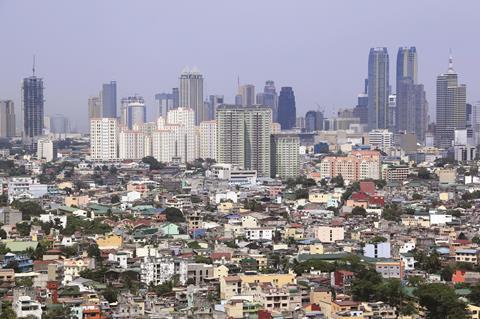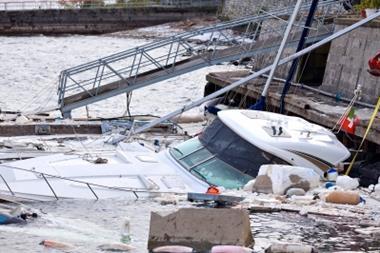The country has one of the fastest-growing economies in the world, but income inequalities, a growing population and being on a typhoon path mean it remains vulnerable

Risk will always be a subjective consideration: a threat to some is an opportunity to others. Risk exists everywhere and manifests itself in everything. Its scale, from non-existent or mild to serious and omnipresent, depends on perception and appetite.
For businesses operating in the Philippines many of the risks faced can be considered to be at the sharper end of the spectrum. Some extraordinary possibilities for growth exist, but there can also be a price to pay in terms of risk exposure in this country of genuine extremes, as StrategicRISK’s recent roundtable in Manila showed.
Attended by the country’s leading risk managers and brokers, the risk professionals who took part in the discussion represented a broad cross-section of the largest and most important businesses operating in the Philippines and included representatives from the state and private sector.
From the roundtable conversation, it is clear the Philippines is fast-moving and exciting. Freed from the shackles of dictatorship in the mid-1980s, this vibrant young democracy has an almost tangible energy. It is easy to see, therefore, why there is real optimism for the future, particularly when looking at its recent performance. But can this be maintained in the longer term?
The Philippines has one of the fastest-growing economies in the world, with GDP rising by about 7% for the past three years. Unsurprisingly, many economic analysts consider it to be the “most promising” of the emerging Asian nations, particularly since its debt rating was raised to investment grade last year.
Some of this financial boom has been fuelled by the rapid growth of service industries. Although the potential for mining and manufacturing is significant, with mineral reserves valued at an estimated $300bn (€225bn) as yet untapped, business process outsourcing (BPO) is the engine driving much of this economic juggernaut.
The BPO sector is currently expanding by about 30% year on year, however, the views about its real impact on the country are mixed. Certainly, it has helped grow the economy, but some question whether it is beneficial for the Philippines in the long term because it attracts highly educated people away from jobs for which they are better qualified but that pay less, if they exist at all.
The Business Processing Association of the Philippines estimates this industry has almost one million full-time employees. One roundtable participant suggested the number of call centre jobs had led to a “bubble of people without specialised skills” as they ignored further educational experiences in favour of “having their immediate needs addressed by the economic benefits provided by this sector”.
Whether the critics of BPO are correct or wrong, keeping up with the growth curve at its current rate will not be easy.
Sustainable growth
Finding and developing new ways to make money is a common concern among this rapidly shifting business landscape. “Discovering and monetising new revenue streams is the biggest challenge we are tackling now,” says Christine Renee Blabagno, head of ERM at telecommunications company Globe Telecom, “as we know that the erosion of traditional revenue streams is accelerating for mobile operators across the globe”.
A risk manager from the power sector who wishes to remain anonymous agrees, but says the focus in his sector remains on satisfying an increasingly hungry market. “There is a lot of pressure for energy companies to come up with levels of supply to meet demand,” he says.
“The big risk for us is how to get the big opportunities, prioritise them and execute them in the time in which the market requires.”
Wider concerns arise that this apparent economic success story might not be all it seems as the country’s new wealth is failing to filter through to the majority of its population, who remain desperately poor. Instead, a large amount of the money pours into the accounts of a small group that controls the majority of the country’s big business at the exclusion of others, including foreign investors who are keen to develop interests in the Philippines but prevented by law from doing so.
As a consequence, if this situation is not addressed, the fears voiced regarding whether growth is sustainable will become louder and louder, particularly with a population who is expanding almost as quickly as its GDP.
The Philippines is the fourth most populous nation in the Asia-Pacific region but not, perhaps, for long. With Japan’s population set to decline while the number of Filipinos increases, it is likely that soon only China and Indonesia will have larger numbers. In July 2014, a child named Chonalyn was born in Manila. Her arrival took the population of the Philippines to 100 million, marking a phenomenal increase of 40 million in under 25 years. The population is expanding so rapidly that it is predicted to rise another 20% within eight years and reach 150 million by 2050.
Managing these numbers in a meaningful and effective way will not be easy, as Chris Dale, chief executive of Aon in the Philippines points out. “The government has major issues to address around population growth and access to jobs,” he says.
“You have significant population growth and significant economic growth. Yet, none of this growth is inclusive. I am not talking about inclusive growth in terms of wealth distribution, but it is about access to education and healthcare.”
Brain drain and regulation
A perceived decline in the number of students getting into highly technical professions is also affecting the ability of companies in the Philippines to compete on the international stage.
Of those who resisted the temptation of BPO wages, a number of our roundtable participants suggested the best and brightest of the country’s talent often moved overseas in search of “greener pastures”.
Many Filipinos leave the country to work abroad, where they can earn more and have better prospects, even if they are overqualified for their roles. People often shun highly technical professions at home to work in the service or hospitality sectors abroad.
One positive consequence of this is that the FOREX reserves of the Philippines are strong with so many expatriates sending money home, but this is hardly a solution to a long-term problem that has started to manifest itself already: in essence, how does the country manage its growth effectively?
Some might consider regulatory issues form an unwanted barrier to this but most risk professionals StrategicRISK spoke to agree that although regulations are sometimes cumbersome, they are a necessity. The volume of regulation is not necessarily changing, but enforcement is becoming stricter. Businesses accept this is an essential requirement as the government toughens its stance against the type of corruption that used to be endemic.
“The regulatory environment in which our power industry operates has been stringent and this has caused some delays in the implementation of projects,” says a risk manager on condition of anonymity.
“Hopefully, this will end soon. Overregulation is never a solution, but we are going through a phase of transition because the Philippines is still a young country.”
Geographical vulnerabilities
It may indeed be new in terms of its democratic status, but some of the nation’s problems are as old as time itself.
By virtue of its geographical location, the Philippines is one of the most vulnerable places on earth in terms of catastrophe risk. The country straddles the earth’s biggest natural danger zone, the Ring of Fire. This connected belt of seismic activity brings an ever-present threat of earthquake and volcanic eruption.
Seismologists expect a major event will hit the Philippines – a one in 350-year earthquake – soon, but predicting where and when it will strike is an inexact science.
What can be forecast with greater certainty is the risk of a major storm. The Philippines lies in the centre of the so-called Typhoon Superhighway – a route that carries about 20 major storms of varying severity across the country each year.
Vulnerability to typhoons is not a recent phenomenon, but their ferocity and impact appear to be changing. In November 2013, Haiyan became the strongest typhoon ever recorded to
hit land as it blew across some of the islands comprising the Philippines.
The damage and casualty rate was significant – 6,300 people died – but the toll would have been magnified many times had the strong side of Haiyan struck more densely populated areas.
With about one-third of the population of the country living in or around the capital Manila, there is a concentration of risk that could, if nature conspires against it, cause utter devastation not only to the city and the country’s economy, but to millions of its people.
At one stage, Haiyan was tracking towards Manila only to shift course as it bore down on the islands. It was a lucky escape that might not be repeated again.
Manufacturing facilities and infrastructure projects are at risk from floods, high winds and storm surges. Many facilities have been reinforced and elevated and the government’s disaster planning is evolving continually, yet despite these improvements it is likely not enough protection is in place for a major catastrophic event.
“People often talk about climate change as being in the future – in the Philippines, climate change is today,” says Jan Mumenthaler, principal insurance officer, International Finance Corporation in the Philippines.
“There is an urgent need for businesses and the government to become more resilient, so that communities and businesses can sustain their future. Some areas might become deserted because the risk of living or doing business there becomes too great.”
With such extreme exposure, the likelihood of being affected by a major natural event is particularly high and, as such, catastrophe risk lies at the forefront of considerations not only for companies and government but, more importantly, also for the nation’s inhabitants, who grow up surrounded by danger from nature. It is perhaps because of this that Filipinos are not risk averse. Indeed, stoicism and resilience appear part of their DNA, together with a generally positive demeanour that often masks the difficult and impoverished lives many continue to endure.
“Manila is among the four global cities most vulnerable to natural disaster,” says Dale. “The first strong typhoon of this year hit Manila in July – it brought wind, but not rain. Still, it shut down the city for 24 hours. When you talk about a city shutting down for 24 hours, what consequences will this type of event have in the future?”
It is a question many in Manila fear will be answered soon.
“The risk management plans exist, but whether they can cope with a catastrophe event of such severity [as Haiyan] I doubt it,” says Mumenthaler. Mike Jones
Top risks
Natural catastrophe
Located in the centre of the Typhoon Superhighway, the Philippines is hit by about 20 typhoons of varying severity each year, bringing rain, wind and storm surges. Earthquakes and volcanic activity also provide significant threats.
Climate change
Linked to an increase in the ferocity and intensity of storms in the region. Typhoon Haiyan, which hit the Philippines in 2013, was the largest of its type ever recorded to hit land. Some 6,300 people died and damage was estimated at $3bn.
Regulation
The government of Benigno ‘Noynoy’ S Aquino, which was elected in 2010, has sought to crack down on the type of corruption once endemic across the Philippines. A tougher regulatory stance has been central to this policy, which is focused on enforcement of existing regulation rather than the introduction of new laws. Progress has been slow as the problem was so deeply rooted, but it is starting to have a positive effect.
Human capital
Up to 10 million Filipinos work outside the country, which raises concerns of a brain drain that has removed the best minds from the Philippines. Attracting and retaining the right talent is a serious issue for companies as the country seeks to sustain development.
Education
Greater investment in education is needed to benefit the general population, particularly those in poor or remote communities. More technical skills are required to support the country’s economic growth.
Sustainability
GDP growth has been about 7% since 2012 but maintaining this rate will be difficult with an uneven economy that concentrates on services – particularly business process outsourcing. State investment is needed or provisions should be made to allow new private sector investors to develop manufacturing and other industry. Also, wealth created by the current boom is still concentrated among a small number of groups and has not filtered to ordinary Filipinos.
Competing with other countries in the region
The Philippines might be enjoying an economic boom, but it is not the only country within the Asia-Pacific region to do so. Competitor nations such as Vietnam and Indonesia potentially offer more flexibility and opportunity for business.
Reputation
The importance of a strong brand has been recognised in the Philippines for many years. Now businesses are starting to realise the significance of reputational issues in terms of enhancing their status and also the associated risk of damage.
Thought leadership
NICK WILDGOOSE Global supply chain product manager, Zurich Insurance Group
The Philippines is one of the world’s most exposed nations to natural catastrophes, and manufacturers in the country need to reconsider their business interruption strategy. Indeed, many companies are starting to think about the risks they could face and developing a better understanding of the impact of an interruption on their business.
Often, organisations are too focused on internal supply chains, rather than on the external supply chain. Often, owing to cost pressures, companies do not explore proper risk management. However, failure to deliver can have a detrimental effect on a company’s profitability. ‘Proactive’ risk management on more than a selective risk basis can add value and help companies to have a competitive advantage.
Our experience has shown that it is more important to understand the nature of the generic supply chain vulnerabilities and then to formulate cohesive ways of addressing them. This should include implementation of proactive mitigation actions to help reduce the likelihood of an adverse consequence; reactive plans and frameworks to help limit the impact if an event does happen; and agreeing on risk transfer programmes, such as insurance, to help provide monetary remuneration.
Rather than try to predict the next incident or unforeseen event that could disrupt operations, companies can examine whether their suppliers at various levels are at risk from a number of broader perils. Could an incident such as a flood or earthquake damage the supplier’s premises? Is the supplier likely to go insolvent? Who or what does a supplier depend on? Who or what are the critical elements to ensure delivery, such as security, packaging or even the availability of labour? Are there any political, geographic or economic issues related to where the supplier is based? Is the quality of the goods and services being received consistent? To what extent is the supply chain dependent on particular transportation routes and what alternatives are required? Are there any other characteristics that make the supply routing vulnerable? Is risk management embedded in the supplier selection and ongoing performance management processes? Are the risk management processes being operated in an optimal manner?
It is clear that only those companies that develop robust risk management strategies with a better understanding of their supply chain will remain resistant the impact of natural catastrophes.




















No comments yet